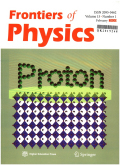Self-organized criticality in multi-pulse gamma-ray bursts
基本信息来源于合作网站,原文需代理用户跳转至来源网站获取
摘要:
The variability in multi-pulse gamma-ray bursts (GRBs) may help to reveal the mechanism of underlying processes from the central engine.To investigate whether the self-organized criticality (SOC) phenomena exist in the prompt phase of GRBs,we statistically study the properties of GRBs with more than 3 pulses in each burst by fitting the distributions of several observed physical variables with a Markov Chain Monte Carlo approach,including the isotropic energy Eiso,the duration time T,and the peak count rate P of each pulse.Our sample consists of 454 pulses in 93 GRBs observed by the CGRO/BATSE satellite.The best-fitting values and uncertainties for these power-law indices of the differential frequency distributions are: αdE=1.54±0.09,αdT=1.82+0.14-0.15 and αdP =2.09+0.18-0.19,while the power-law indices in the cumulative frequency distributions are: αcE=1.44+0.08-0.10,αcT=1.75+0.11-0.13 and αcP =1.99+0.16-0.19,We find that these distributions are roughly consistent with the physical framework of a Fractal-Diffusive,Self-Organized Criticality (FD-SOC) system with the spatial dimension S =3 and the classical diffusionβ=1.Our results support that the jet responsible for the GRBs should be magnetically dominated and magnetic instabilities (e.g.,kink model,or tearing-model instability) lead the GRB emission region into the SOC state.

推荐文章
低能量X-RAY测厚仪与β-RAY
测厚仪
薄膜
应用
比较
一种基于用户行为的Self集构造和演化方法
计算机免疫
演化计算
计算机安全
入侵检测
Gamma函数的倍元公式的几种证法
Gamma函数
Beta函数
Legendre加倍公式
Prospectivity modeling of porphyry copper deposits: recognition of efficient mono- and multi-element
Geochemical signature
Concentration–area (C–A) fractal
Principal component analysis (PCA)
Student's t-value
Fuzzy mineral prospectivity modeling(MPM)
Prediction–area (P–A) plot
内容分析
关键词云
关键词热度
相关文献总数
(/次)
(/年)
引文网络
引文网络
二级参考文献 (0)
共引文献 (0)
参考文献 (38)
节点文献
引证文献 (0)
同被引文献 (0)
二级引证文献 (0)
1977(1)
- 参考文献(1)
- 二级参考文献(0)
1986(1)
- 参考文献(1)
- 二级参考文献(0)
1987(1)
- 参考文献(1)
- 二级参考文献(0)
1988(1)
- 参考文献(1)
- 二级参考文献(0)
1992(1)
- 参考文献(1)
- 二级参考文献(0)
1993(1)
- 参考文献(1)
- 二级参考文献(0)
1999(1)
- 参考文献(1)
- 二级参考文献(0)
2000(1)
- 参考文献(1)
- 二级参考文献(0)
2002(1)
- 参考文献(1)
- 二级参考文献(0)
2004(1)
- 参考文献(1)
- 二级参考文献(0)
2005(2)
- 参考文献(2)
- 二级参考文献(0)
2006(3)
- 参考文献(3)
- 二级参考文献(0)
2010(1)
- 参考文献(1)
- 二级参考文献(0)
2011(3)
- 参考文献(3)
- 二级参考文献(0)
2013(3)
- 参考文献(3)
- 二级参考文献(0)
2014(5)
- 参考文献(5)
- 二级参考文献(0)
2015(5)
- 参考文献(5)
- 二级参考文献(0)
2016(2)
- 参考文献(2)
- 二级参考文献(0)
2017(2)
- 参考文献(2)
- 二级参考文献(0)
2018(2)
- 参考文献(2)
- 二级参考文献(0)
2021(0)
- 参考文献(0)
- 二级参考文献(0)
- 引证文献(0)
- 二级引证文献(0)
引文网络交叉学科
相关学者/机构
期刊影响力
物理学前沿
主办单位:
高等教育出版社
出版周期:
双月刊
ISSN:
2095-0462
CN:
11-5994/O4
开本:
出版地:
北京市朝阳区惠新东街4号富盛大厦15层
邮发代号:
创刊时间:
语种:
eng
出版文献量(篇)
1093
总下载数(次)
0
总被引数(次)
1881
期刊文献
相关文献
推荐文献

 免费查重
免费查重










